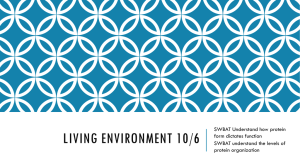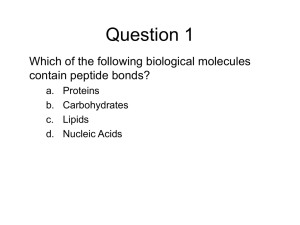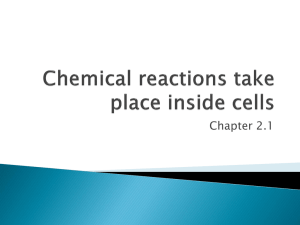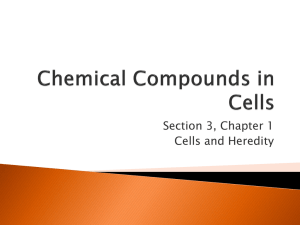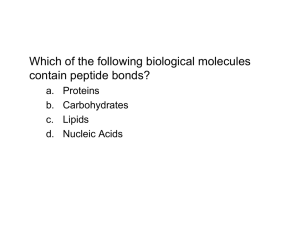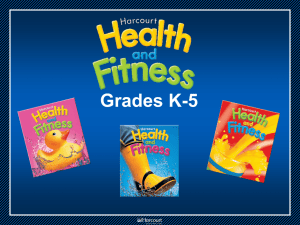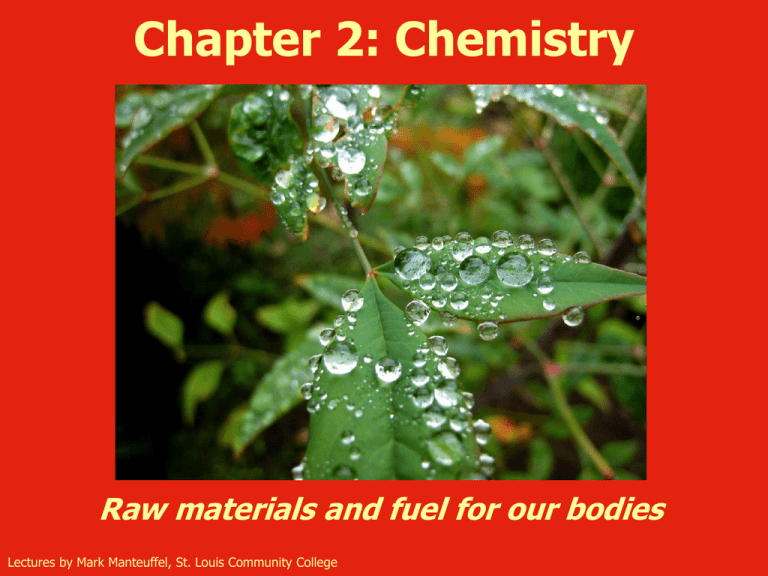
Chapter 2: Chemistry
Raw materials and fuel for our bodies
Lectures by Mark Manteuffel, St. Louis Community College
Learning Objectives
Describe what atoms are, their structure, and how they
bond.
Understand water’s features that help it support all life.
Describe carbohydrates—their structure and function.
Learning Objectives
Describe lipids—their structure and function.
Describe proteins—their structure and function.
Describe nucleic acids—their structure and function.
2.1 Everything is made of atoms.
An element is a
substance that cannot
be broken down
chemically into any other
substances.
An atom is a bit of
matter that cannot be
subdivided any further
without losing its
essential properties.
Atomic Structure:
The nucleus, protons, and neutrons
Atomic Structure: Electrons
Atomic Numbers
25 Elements Found in Your Body
and the Big 4
Take-home message 2.1
Everything
around us, living or not, is made
from atoms, the smallest unit into which
material can be divided.
Atoms
They
all have the same general structure.
are made up of protons and neutrons in
the nucleus and electrons, which circle far
around the nucleus.
2.2 An atom’s electrons
determine how (and whether) the
atom will bond with other atoms.
Electron shells
Electron Shells
Ions
Take-home message 2.2
The
chemical characteristics of an atom
depend upon number of electrons in their
outermost shells.
Atoms
are most stable and least likely to
bond with other atoms when their outermost
electron shell is full.
2.3 Atoms can bond together to
form molecules or compounds.
Molecules
Products of bonding!
Covalent Bonds
Ions and Ionic Bonds
Hydrogen Bonds
Take-home message 2.3
Atoms
can be bound together in three
different ways.
Covalent
bonds, in which atoms share
electrons, are the strongest.
Take-home message 2.3
In
ionic bonds, the next strongest, one
atom transfers its electrons to another and
the two oppositely charged ions are
attracted to each other, forming a
compound.
Take-home message 2.3
Hydrogen
bonds, the weakest, involve the
attraction between a hydrogen atom and
another polar atom or molecule.
2.4 A molecule’s shape gives it
unique characteristics.
Molecular
Shape
Personalities
determines function
• Physical properties such as:
»Taste
»Smell
Molecular Interactions
and Insect Mating Behavior
Take-home message 2.4
The
properties of a molecule—such as
how the molecule tastes or smells, or its
likelihood of bonding with other
molecules—depend upon the shape in
which the atoms are linked together and
the electrons in their outermost shells.
2.5 Hydrogen bonds make water cohesive.
Take-home message 2.5
Water molecules easily form hydrogen
bonds, giving water great cohesiveness.
2.6 Water has unusual properties
that make it critical to life.
Cohesion
Large
Low
heat capacity
density as a solid
Good
solvent
Cohesion
Heat Capacity
Why do coastal areas have
milder, less variable climates
than inland areas?
Low Density as a Solid
Why don’t oceans freeze as
easily as fresh water lakes?
Take-home message 2.6
The
hydrogen bonds between water
molecules give water several of its most
important characteristics:
•
•
•
•
cohesiveness
low density as a solid
the ability to resist temperature changes
broad effectiveness as a solvent
2.7 Living systems are highly
sensitive to acidic and basic
conditions.
Hydrogen Ions
and Hydroxide Ions
OH -
O
H
Ionized Hydroxide
Molecule
H2O
O
H
H
Non-Ionized Water
Molecule
pH Scale
The
amount of H+ in a solution is a
measure of its acidity and is called pH.
Acids
Bases
H+ Ions and Acids
H+
very reactive
Acids
can donate H+ to other chemicals
Stomach
acids
Bases
Low
H+
High OH
Antacids
Baking
soda, seltzer, milk of magnesia
Blood pH
Buffers
• can quickly absorb
excess H+ ions to
keep a solution from
becoming too acidic,
• and they can quickly
release H+ ions to
counteract any
increases in OH
concentration.
Take-home message 2.7
The
pH of a fluid is a measure of how acidic
or basic a solution is and depends on the
concentration of dissolved H+ ions present.
Acids,
such as vinegar, can donate protons
to other chemicals while bases, including
baking soda, bind with free protons.
2.8 Carbohydrates are macro-molecules
that function as fuel.
Health topics of
the year
Low-carb diet?
Hi-carb diet?
“Carbo-loading”?
Fiber intake?
What are
carbohydrates?
Four Types of Macromolecules
Carbohydrates
Lipids
Proteins
Nucleic
acids
Carbohydrates
C,
H, and O
Primary
fuel for
organisms
Cell
structure
Energy is in the chemical
bonds!
Take-home message 2.8
Carbohydrates
are the primary fuel for
running all cellular machinery and also
form much of the structure of cells in all
life forms.
Take-home message 2.8
Carbohydrates
contain carbon, hydrogen,
and oxygen, and generally have the same
number of carbon atoms as they do H2O
units.
Take-home message 2.8
The
C-H bonds of carbohydrates store a
great deal of energy and are easily
broken by organisms.
2.9 Simple sugars are the most
effective source of energy.
Monosaccharides
37
carbon atoms
Glucose
and fructose
Glucose
Most
carbohydrates
— ultimately
converted into
glucose
Blood
sugar
What is “carbo-loading”?
Take-home message 2.9
The
simplest carbohydrates are called
monosaccharides or simple sugars.
They
contain from three to seven carbon
molecules.
The
sugar glucose is the most important
carbohydrate to living organisms.
2.10 Complex carbohydrates are
time-released packets of energy.
More
than 1 sugar (monosaccharide) unit
Disaccharides
•
•
sucrose
lactose
Polysaccharides
•
•
starch
cellulose
Chemical Fuel
Preliminary Processing
Starch
>
100’s of glucose molecules joined
together
Barley,
wheat, rye, corn, and rice
Glycogen—“animal
starch”
Complex Carbohydrates
“Time-release” fuel pellets
Take-home message 2.10
Multiple
simple carbohydrates sometimes
link together into more complex
carbohydrates.
Types
of complex carbohydrates include
starch, the primary form of energy storage
in plants, and glycogen, a primary form of
energy storage in animals.
2.11 Not all carbohydrates are
digestible.
Chitin
Cellulose
Fiber
“Roughage”
Colon
cancer prevention/reduction
Termites
ecological role
Take-home message 2.11
Some
complex carbohydrates, including
chitin and cellulose, cannot be digested by
most animals.
Such
indigestible carbohydrates in the
diet, called fiber, aid in digestion and have
numerous health benefits.
2.12 Lipids are macromolecules with several
functions, including energy storage.
Why does a salad dressing made with
vinegar and oil separate into two layers
shortly after you shake it?
Hydrophobic
Hydrophilic
Take-home message 2.12
Lipids
are non-soluble in water and greasy
to the touch.
They
are valuable to organisms in longterm energy storage and insulation,
membrane formation, and as hormones.
2.13 Fats are tasty molecules
too plentiful in our diets.
Glycerol:
region
Fatty
“head”
acid “tails”
Triglycerides
Fat molecules contain much more stored
energy than carbohydrate molecules.
Saturated and Unsaturated Fats
# of bonds in the hydrocarbon chain in a fatty acid
Health considerations
Chocolate
chip cookie recipes call for
some lipids.
How
will the “chewy-ness” of the
cookies differ depending on whether
you use butter or vegetable oil as the
lipid?
Which
cookies will be healthier?
Many
snack foods contain “partially
hydrogenated” vegetable oils.
Why
might it be desirable to add
hydrogen atoms to a vegetable oil?
What are trans fats?
Olestra
is a recently developed “fake
fat” chemical that gives foods the
taste of fat, without adding the
calories of fats.
What
chemical structure might make
this possible?
Take-home message 2.13
Fats,
including the triglycerides common in
the food we eat, are one type of lipid.
Take-home message 2.13
Characterized
by long hydrocarbon tails, fats
effectively store energy in the bonds
connecting the molecules.
Organisms
prefer fats in their diets because
of the high calories, but this also causes
obesity and illness in today’s modern world.
2.14 Cholesterol and
phospholipids are used to build
sex hormones and membranes.
Not
all lipids are fats
The
sterols
Cholesterol
Important
component of most cell
membranes.
Can
attach to blood vessel walls and cause
them to thicken.
Cells
in our liver produce almost 90% of
the circulating cholesterol.
Steroid
Hormones
Estrogen
Testosterone
• synthetic variants
of testosterone
Phospholipids and Waxes
Phospholipids
are the major component
of the cell membrane.
Waxes
are strongly hydrophobic.
Take-home message 2.14
Cholesterol
and phospholipids are lipids
that are not fats.
Both
are important components in cell
membranes.
Cholesterol
also serves as a precursor to
steroid hormones, important regulators of
growth and development.
2.15 Proteins
are versatile
macromolecules
that serve as
building blocks.
Amino Acids
Twenty
Strung
different amino acids
together to make proteins
Take-home message 2.15
Unique
combinations of 20 amino acids
give rise to proteins, the chief building
blocks of physical structures that make up
all organisms.
Proteins
perform myriad functions.
2.16 Proteins are an essential
dietary component.
Growth
Repair
Replacement
Food
labels indicate an item’s protein
content.
Why
is this insufficient for you to
determine whether you are protein
deficient, even if your protein intake
exceeds your recommended daily
amount?
Complete Proteins
Have
all essential amino acids
Incomplete
proteins
Complementary
proteins
Take-home message 2.16
Eight
of the 20 amino acids are essential
amino acids and cannot be made by the
body so must be consumed in the diet.
Complete
proteins contain all eight
essential amino acids, while incomplete
proteins do not.
2.17 Protein functions are influenced
by their three-dimensional shape.
Peptide
bonds
Primary Structure
The
sequence
of amino acids
Secondary Structure
Hydrogen
bonding
between amino acids
The two most common
patterns:
• twist in a corkscrew-like
shape
• zig-zag folding
Tertiary Structure
Folding
and
bending of the
secondary structure
Due
to bonds such
as hydrogen bonds
or covalent sulfursulfur bonds.
Quaternary Structure
When
two or more
polypeptide chains
are held together by
bonds between the
amino acids on the
different chains.
Hemoglobin
Egg
whites contain much
protein.
Why
does beating them
change their texture, making
them stiff?
Egg
whites contain much protein.
Why
does beating them change
their texture, making them stiff?
Why is wet hair easier to style
than dry hair?
Why do some people have curly hair
and others have straight hair?
Take-home message 2.17
The particular amino acid sequence of a protein
determines how it folds into a particular shape.
This shape determines many of the protein's
features, such as which molecules it will interact
with.
When a protein's shape is deformed, the protein
usually loses its ability to function.
2.18 Enzymes are proteins that
initiate and speed up chemical
reactions.
“Misspelled” Proteins
Incorrect
Active
amino acid sequence
site disruptions
Phenylketonuria
Why do some adults get sick
when they drink milk?
Take-home message 2.18
Enzymes
are proteins that help initiate and
speed up chemical reactions.
They
aren't permanently altered in the
process but rather can be used again and
again.
2.19 Nucleic acids are macromolecules
that store information.
Two Types of Nucleic Acids
Deoxyribonucleic
acid (DNA)
Ribonucleic acid
(RNA)
Both play central roles
in directing the
production of proteins.
Information Storage
The
information in a molecule of DNA is
determined by its sequence of bases.
Adenine,
guanine, cytosine, and thymine
• CGATTACCCGAT
Take-home message 2.19
The
nucleic acids DNA and RNA are
macromolecules that store information by
having unique sequences of molecules.
Both
play central roles in directing protein
production in organisms.
2.20 DNA holds the genetic
information to build an organism.
Base-Pairing
A
&T
G
&C
What
is the complimentary strand to
this strand: CCCCTTAGGAACC?
Take-home message 2.20
DNA
is like a ladder in which the long
vertical element of the ladder is made
from a sequence of sugar-phosphatesugar-phosphate molecules and rungs are
nucleotide bases.
The
sequence of nucleotide bases contains
the information about how to produce a
particular protein.
2.21 RNA is a universal translator,
reading DNA and directing protein
production.
RNA differs from DNA in three
important ways.
The
sugar molecule of the sugarphosphate backbone
Single-stranded
Uracil
(U) replaces thymine (T)
Take-home message 2.21
RNA
acts as a middleman molecule—
taking the instructions for protein
production from DNA to another part of
the cell where, in accordance with the
RNA instructions, amino acids are pieced
together into proteins.
Learning Objectives
Describe what atoms are, their structure, and how they
bond.
Understand water’s features that help it support all life.
Describe carbohydrates—their structure and function.
Describe lipids—their structure and function.
Describe proteins—their structure and function.
Describe nucleic acids—their structure and function.


